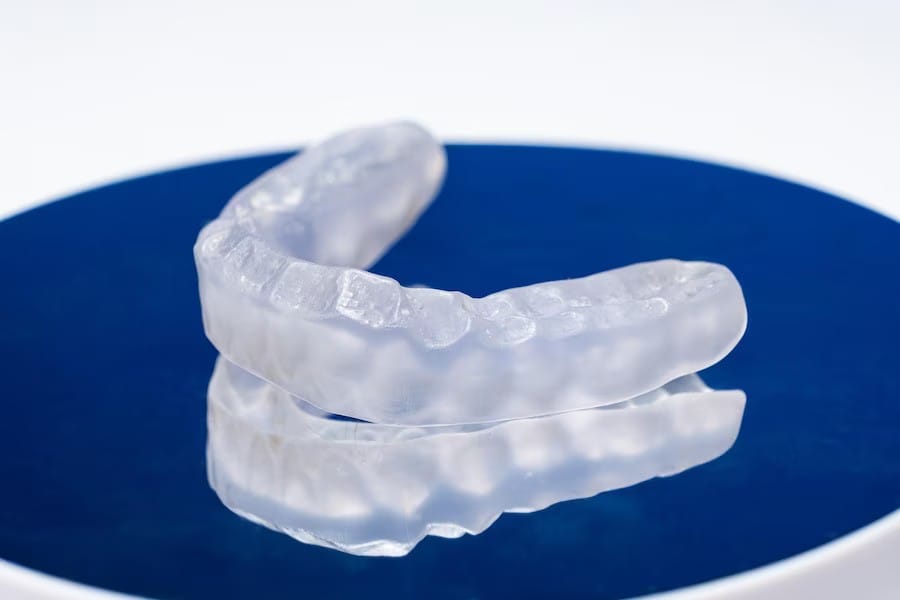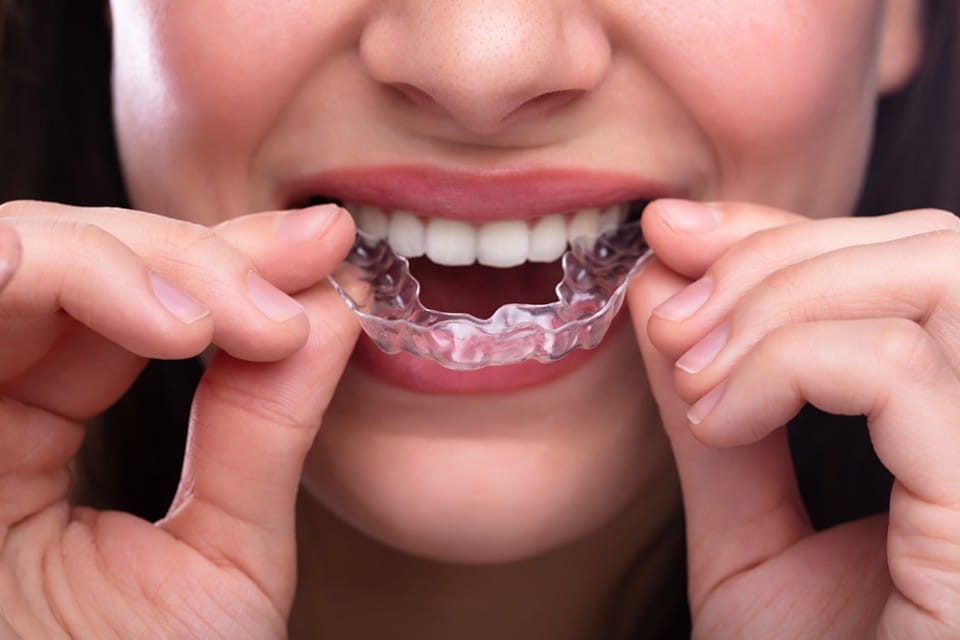WHAT ARE OCCLUSAL SPLINTS AND WHY DO YOU NEED THEM?
An occlusal splint or a mouth guard is an orthotic device that is specifically designed with the help of computer technology. It fits over the surface of upper and lower teeth, reduces tension, and stimulates jaw movement. Dental professionals usually recommend occlusal splints for people who grind their teeth or have a history of pain and dysfunction associated with their temporomandibular joints (TMJ).
Splints offer an effective and non-invasive treatment for jaw disorders and protect dentition. They are usually worn at night, but if your habits of teeth clenching or bruxism are severe, your dentist may advise you to wear them during the day as well. Keep reading to learn how these dental devices protect your oral health and why you need them.
SIGNS AND SYMPTOMS THAT INDICATE YOU MIGHT NEED AN OCCLUSAL SPLINT:
An occlusal splint is fabricated with a combination of high-impact acrylic and thermoplastic material. This rigid material protects the surfaces of the teeth from abrasion and effectively absorbs pressure generated during bruxism.
It may also relieve stress on the jaw joint and alleviate the symptoms of muscle and joint pain. You might be in need of an occlusal splint if you are suffering from any of the following issues:
- Clenching and grinding
- Fractured, cracked or loose teeth
- Headache, sore jaws or ear pain
- Toothache and stiffness in the face and temples
- Pain in jaws while eating
- Sensitivity to hot and cold
- Temporomandibular dysfunction (TMD)
- Premature wear and tear of teeth
Occlusal splints are custom-made to eradicate all these issues and provide people with a good night’s sleep. Besides aiding in the management of bruxism, splints also realign the mouth and eliminate the need for complex dental procedures.
TYPES OF OCCLUSAL SPLINTS:
There are usually two types of occlusal splints that you can opt for depending on your personal needs and oral condition.
1. PERMISSIVE OCCLUSAL SPLINTS:
Permissive splints are the most common ones that relieve the pressure on the jaw muscles and help prevent bite misalignment. They fit over the upper and lower teeth. Moreover, permissive splints have a smooth bite surface that allows the jaw to close freely and teeth to glide in an unimpeded manner, providing a more symmetrical resting position.
2. NON-PERMISSIVE OCCLUSAL SPLINTS:
Non-permissive splints are particularly designed with indentations to minimize jaw movement. They direct the jawbone to a forward position. This kind of splint is used to treat certain structural disorders in jawbone articulation.
FACTS THAT YOU SHOULD KNOW ABOUT OCCLUSAL SPLINTS:
Before purchasing an occlusal splint, there are various things that you need to consider:
- Occlusal splints need periodic adjustments. However, their number of adjustments depends on the structural condition of the TMJs.
- These splints are not a panacea. Their effectiveness is based on the type of material they are fabricated from.
- If this appliance does not fill well in your mouth, it can cause discomfort or pain.
Furthermore, before getting an occlusal splint, patients should ask everything about this procedure from their dentists to ensure a smooth treatment process.
INSTRUCTIONS FOR WEARING AN OCCLUSAL GUARD:
Dentists usually recommend that patients should wear their mouth guards for at least 4 to 6 weeks. Nevertheless, they need adjustments after some time. In order to get significant results, it is necessary to wear them consistently or as your dental professional recommends.
If you feel pain after getting occlusal splints or they don’t fill correctly in your mouth, you need to consult your dentist. The dentist might take a new impression of your teeth to re-adjust your splint. Moreover, it usually requires almost 2 weeks to build a permanent habit of wearing these mouthguards. So you should wear your occlusal guards at least for this period before going for other treatment options.
WHERE CAN I BUY MY OCCLUSAL GUARD?
After you’ve determined to get these custom-fit occlusal guards, there are two options that you can choose from. You can either buy them from a retailer or get them specifically fabricated for you by your dentist. While getting an occlusal guard from your dentist, you’ll probably have to visit the dentist’s office two times:
- During the first appointment, your dental professional will take the impressions of your mouth and create a mold. After that, the dentists send this mold to a dental lab to start the fabrication of occlusal splints.
- On the second visit, dentists usually assess the splint’s fit, explain how to wear it, and take care of your mouthguard.
If you purchase an occlusal guard from an online retailer, they will most likely send you an impression kit. With the help of this kit, you can make an impression of your mouth by yourself. After taking impressions, you can send them to the dental lab, where your guard will be prepared. It will then be delivered to you, and you can wear it as needed.
There are also “one-size-fits-all” occlusal splints that you can buy, but such guards don’t usually have durability. Moreover, they cannot be adjusted or customized and often cause discomfort because of their ill-fitting.
AVERAGE COSTS OF OCCLUSAL SPLINTS:
The estimated costs of occlusal splints typically fluctuate based on a variety of factors. They can depend on the complexity of the appliance, the type of material used and the dental clinic that provides it. In general, an occlusal splint can cost you around $550 to $1,000. However, mostly, dental insurance covers all or a specific part of the fabrication costs.
In the long run, occlusal splints prove to be extremely cost-effective and the best option for correcting oral issues. This is because they eliminate issues regarding your jawbone articulation in the starting and minimize the need for complex oral treatments. In this way, they save you a great deal of time and money.
ARE THERE ANY SIDE EFFECTS OF OCCLUSAL SPLINTS?
In some cases, when an occlusal splint does not fit you well, it can trigger discomfort or pain. Such guards also contribute to issues like tooth sensitivity, difficulty breathing, temporary muscle pain, or excessive salivation. But these are rare instances and occur mostly in the case of an ill-fitted occlusal splint.













